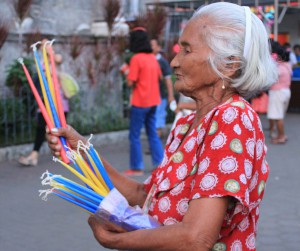By AMER R. AMOR
AT the height of the Sinulog Festival’s street dancing competition in Cebu City on Jan. 15, young women, dubbed as “Festival Queens,” carried the Santo Nino and led thousands of dancers and spectators as the city celebrated the feast of the Holy Child Jesus. Garbed in their most festive costumes, they endured an entire day of dancing and merrymaking as they paraded along the main thoroughfares.
Far from the madding crowd of Sunday’s competition, just outside the Basilica del Sto. Nino, another group of women sans make-up and colorful costumes, and with no photographers scampering around them, danced as well as they offered prayers of gratitude, repentance and supplication to the Holy Child Jesus. Swaying to the beat of their own prayers uttered in Cebuano, they are the ties that bring devotees closer to the Sto. Nino.
“We are actually candle vendors whom devotees ask to dance their prayer requests. And we do so wholeheartedly. It’s a practice that I have learned from my relatives,” said Ruby Meonis, one of the vendors.
Along with the other women known as tindera sinulog, Meonis brings to life almost every day a tradition originally conceived as a ritual dance but which the Spaniards adopted as a dance of worship for the Sto. Nino. Theirs is a performance that goes beyond the festivities that surround the Philippines’ biggest and grandest festival.
Meonis, 32, is one of the youngest among these women, having started to dance in prayers just three years ago. Born to a family of candle vendors from the town of Minglanilla in Cebu, Meonis has witnessed as a child how her relatives religiously danced in prayer, and have been blessed by the Sto. Nino along the way.
“I live in a neighborhood where candles are made and where most people are candle vendors. I tried other jobs first, but I realized I grew up with this. It is my way of continuing our family’s tradition. It pays for my child’s diaper and for our food, but more importantly, I also get closer to Senyor (Holy Child Jesus),” said Meonis.
For 89-year-old Leonesa Alicaya, her trips to Basilica del Sto. Nino to dance on behalf of the devotees who buy candles from her have become her life. Having to raise her six children after her husband died, Alicaya seeks refuge within the Basilica. She learned from observing how the vendors dance in prayers and started to perform the sinulog in 1957. To this day, even when she has all the reasons to stop dancing, her trips to the Basilica continue.
“This is my life now. When I am here and I dance for the devotees, I feel alive. I tried staying at home when my children requested me to stop already, but I got weak. I have to be here every day. I am happy here,” Alicaya, the oldest among the tindera sinulog, said.
She has no more requests, she said, only gratitude to the Holy Child Jesus whom she credits for helping her raise her six children. She also counts her grandchildren as Sto. Nino’s blessings to her, one of whom is already a teacher.
“Without me selling candles, and without me praying to Senyor, I don’t know if I can be able to survive all the hardships that I went through,” she said.
She remembers bringing all her children with her to the Basilica when she started peddling candles and is grateful she did so since all of her children turned out to be devotees of the Sto. Nino as well.
With the candles she bought for P4 per one hundred pieces and resold at five centavos each, she recalls that her income was meager 55 years ago, but her faith to the Holy Child Jesus saw her through.
The candles, which come in different colors now, are sold at P10 each. When devotees pray, they light the red candle for the Sto. Nino and the blue one for the Virgin Mary. The yellow is for good health while the green is for prayer requests on business and career, Alicaya said. Their dancing and their prayers remain free.
Not far from Alicaya, 65-year-old Lucila Belacho has just danced in prayer as well. No one asked her to do so, but she has a wish she is fervently hoping Senyor would grant. She has been saying the same prayer for the last five years.
“I only have one prayer every day, every Sinulog. And that is for my daughter to finally come home,” said Belacho, whose daughter Yvonne left for Manila in 2006 to find work. After contacting them twice once she got to Manila, Yvonne has not been heard of.
Belacho, who started selling candles in 1995, takes care of the five children her daughter has left behind. She does not complain. “But I really pray to Sto. Nino that He keeps my daughter safe and that she will be home soon. It does not matter if she doesn’t have work now or we don’t have money, I just really want her home,” she said.
“I hope that day comes when I no longer have to ask for anything from Him,” Belacho said as she waves her hand to the image of the Sto. Nino being prepared on His way to Iloilo, her voice breaking.
